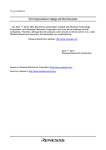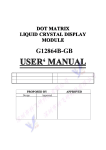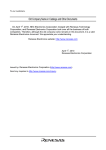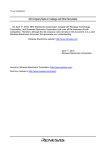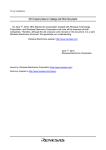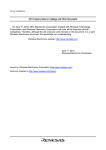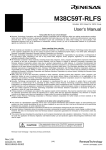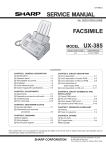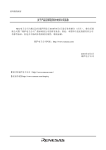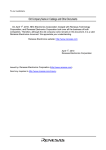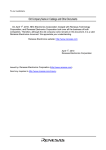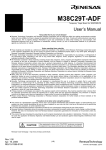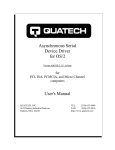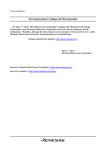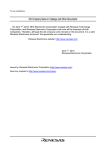Download Renesas M38C89T-ADF User's Manual
Transcript
M38C89T-ADF Temporary Target Board for M38C89RLFS User's Manual Rev.1.00 September 1, 2003 REJ10J0296-0100Z * IC51-1444-1354-18 is a product of Yamaichi Electronics Co., Ltd. Keep safety first in your circuit designs! • Renesas Technology Corporation and Renesas Solutions Corporation put the maximum effort into making semiconductor products better and more reliable, but there is always the possibility that trouble may occur with them. Trouble with semiconductors may lead to personal injury, fire or property damage. Remember to give due consideration to safety when making your circuit designs, with appropriate measures such as (i) placement of substitutive, auxiliary circuits, (ii) use of nonflammable material or (iii) prevention against any malfunction or mishap. Notes regarding these materials • These materials are intended as a reference to assist our customers in the selection of the Renesas Technology product best suited to the customer's application; they do not convey any license under any intellectual property rights, or any other rights, belonging to Renesas Technology Corporation, Renesas Solutions Corporation or a third party. • Renesas Technology Corporation and Renesas Solutions Corporation assume no responsibility for any damage, or infringement of any third-party's rights, originating in the use of any product data, diagrams, charts, programs, algorithms, or circuit application examples contained in these materials. • All information contained in these materials, including product data, diagrams, charts, programs and algorithms represents information on products at the time of publication of these materials, and are subject to change by Renesas Technology Corporation and Renesas Solutions Corporation without notice due to product improvements or other reasons. It is therefore recommended that customers contact Renesas Technology Corporation, Renesas Solutions Corporation or an authorized Renesas Technology product distributor for the latest product information before purchasing a product listed herein. The information described here may contain technical inaccuracies or typographical errors. Renesas Technology Corporation and Renesas Solutions Corporation assume no responsibility for any damage, liability, or other loss rising from these inaccuracies or errors. Please also pay attention to information published by Renesas Technology Corporation and Renesas Solutions Corporation by various means, including the Renesas home page (http://www.renesas.com). • When using any or all of the information contained in these materials, including product data, diagrams, charts, programs, and algorithms, please be sure to evaluate all information as a total system before making a final decision on the applicability of the information and products. Renesas Technology Corporation and Renesas Solutions Corporation assume no responsibility for any damage, liability or other loss resulting from the information contained herein. • Renesas Technology semiconductors are not designed or manufactured for use in a device or system that is used under circumstances in which human life is potentially at stake. Please contact Renesas Technology Corporation, Renesas Solutions Corporation or an authorized Renesas Technology product distributor when considering the use of a product contained herein for any specific purposes, such as apparatus or systems for transportation, vehicular, medical, aerospace, nuclear, or undersea repeater use. • The prior written approval of Renesas Technology Corporation and Renesas Solutions Corporation is necessary to reprint or reproduce in whole or in part these materials. • If these products or technologies are subject to the Japanese export control restrictions, they must be exported under a license from the Japanese government and cannot be imported into a country other than the approved destination. Any diversion or reexport contrary to the export control laws and regulations of Japan and/or the country of destination is prohibited. • Please contact Renesas Technology Corporation or Renesas Solutions Corporation for further details on these materials or the products contained therein. Precautions to be taken when using this product • This product is a development supporting unit for use in your program development and evaluation stages. In mass-producing your program you have finished developing, be sure to make a judgment on your own risk that it can be put to practical use by performing integration test, evaluation, or some experiment else. • In no event shall Renesas Solutions Corporation be liable for any consequence arising from the use of this product. • Renesas Solutions Corporation strives to renovate or provide a workaround for product malfunction at some charge or without charge. However, this does not necessarily mean that Renesas Solutions Corporation guarantees the renovation or the provision under any circumstances. • This product has been developed by assuming its use for program development and evaluation in laboratories. Therefore, it does not fall under the application of Electrical Appliance and Material Safety Law and protection against electromagnetic interference when used in Japan. For inquiries about the contents of this document or product, fill in the text file the installer of the emulator debugger generates in the following directory and email to your local distributor. \SUPPORT\Product-name\SUPPORT.TXT Renesas Tools Homepage http://www.renesas.com/en/tools ( 2 / 14 ) Contents 1. Things to Check When Unpacking ..................................................................................... 4 2. Outline ................................................................................................................................ 4 3. Specifications ..................................................................................................................... 5 4. Setting Up ........................................................................................................................... 6 4.1 Connecting to the Emulator .................................................................................. 6 4.2 Mounting the M38C89MF-xxxFP/M38C89EFFP ................................................ 8 5. Oscillator Circuit ................................................................................................................ 9 5.1 Main Clock Generator Circuit ............................................................................... 9 5.2 Sub Clock Generator Circuit ................................................................................. 9 5.3 How to Use the RC Oscillator Circuit ................................................................. 10 6. Reset Circuit ..................................................................................................................... 10 7. LCD Bias Circuit .............................................................................................................. 10 8. Pin Layout ........................................................................................................................ 11 ( 3 / 14 ) 1. Things to Check When Unpacking The M38C89T-ADF package consists of the following products. When unpacking your package, check to see that all of these components are included. Table 1.1 Contents of the M38C89T-ADF package Item Quantity M38C89T-ADF temporary target board 1 M38C89T-ADF User's Manual (this manual) 1 * If you find any item missing or faulty, or any suggestion, contact your local distributor. 2. Outline The M38C89T-ADF is a temporary target board used to develop software with a PC4701 emulator system. It supplies to the M38C89RLFS MCU the minimum required signals needed to operate the emulator MCU, including power supply voltage, clock signals and reset signals. Use it when the target system is not ready. A block diagram of the M38C89T-ADF is shown in Figure 2.1. IC1 has a pattern for mounting a socket for an M38C89MF-xxxFP/M38C89EFFP. This makes it possible for this board to debug programs using an emulator MCU in IC2 or execute programs using an M38C89MF-xxxFP/M38C89EFFP. A socket for M38C89MF-xxxFP/M38C89EFFP and parts for an LCD bias circuitry are not mounted. Mount them as necessary. Expansion boards can be installed in the through-holes of connectors J2, J3 and J4. Spacing between connectors is given in Figure 2.1. Keep connector location in mind when making expansion boards. Use 2.54-mm-pitch connectors. For pin array, see Table 8.1. Unit: mm Figure 2.1 Block diagram and pin layout ( 4 / 14 ) 3. Specifications Table 3.1 lists specifications of the M38C89T-ADF. Table 3.1 Specifications of the M38C89T-ADF Applicable MCUs IC1: 38C8 Group (M38C89MF-xxxFP/M38C89EFFP) IC2: M38C89RLFS (Emulator MCU) Clock Main clock: 4.0MHz oscillator mounted (for IC2 only) (RC oscillation: approx. 2 MHz*1) Sub clock: 32.768 kHz mounted (for IC2 only) VccM Power supply for IC1 and IC2 (supplied separately*2) VccU Power supply for universal part (supplied separately*2) Vss Common signal ground (supplied separately*2) RESET • Reset circuit mounted (power-on reset and reset switch) • Connects the reset output of an emulation pod External dimensions Others Width 220 mm Depth 160 mm • Universal part prepared • Through hole for 2.54-mm-pitch connector prepared • RC oscillator circuit can be selected as a main clock oscillator*3 • Bias circuit for LCD prepared (parts not mounted) *1 RC oscillation frequency will vary according to MCU power supply voltage, resistance, temperature, etc. That listed herein was measured for reference purposes only and is not guaranteed. *2 Power cannot be supplied from the emulation pod for PC4701 (e.g. M38000TL2-FPD). A separate power supply is needed. *3 Jumpers must be changed to enable RC oscillation. For more information, see "5.3 How to Use the RC Oscillator Circuit" (page 10). ( 5 / 14 ) 4. Setting Up This chapter describes how to set up the M38C89T-ADF. With this product, the debugging with an emulator MCU and M38C89MF-xxxFP/M38C89EFFP is possible. Use the M38C89T-ADF mounting one of these MCUs. To use an emulator MCU: Read "4.1 Connecting to the Emulator" (this page) To use the M38C89MF-xxxFP/M38C89EFFP: Read "4.2 Mounting the M38C89MF-xxxFP/M38C89EFFP" (page 8) CAUTION Note on Setting Up: • Always shut OFF power before connecting the M38C89T-ADF. • Do not mount the IC1 and IC2 at the same time. Mount either of them only. 4.1 Connecting to the Emulator (1) Mounting the emulator MCU Mount the emulator MCU in the IC2 socket on the M38C89T-ADF. Raise the socket's clamp and insert the emulator MCU flush against the socket's left and bottom sides, placing the "•" marking on the emulator MCU at the right bottom corner. Then, lower the clamp to lock the emulator MCU in place. If your emulator MCU does not have the "•" marking on it, use one pin (back of the MCU) for positioning as shown below. MCUs have 20 x 20 pins to the socket's 21 x 21 holes. Since there are more socket holes to MCU pins, insert the MCU flush against the socket's left and bottom sides. The socket is taped to prevent improper MCU mounting. Do not peel off the tape. Figure 4.1 Mounting the emulator MCU on the M38C89T-ADF (2) Connecting the emulation probe Insert the connector on the tip of the emulation pod probe to the J1 of this board. For the direction, see Figure 4.2. (3) Setting the emulation pod (M38000TL2-FPD) As the applicable emulator MCU (M38C89RLFS) for this product is RLFS type, set the switch on the side of the emulation pod to RLSS/RLFS side. ( 6 / 14 ) (4) Connecting the control signal lines Connect the three lines of the emulation pod to the test pins. VCC cable (yellow) ........... VccM (test pin with a yellow bead) GND cable (black) ............. GND (test pin with a black bead) Reset cable (white) ............. RESET (test pin with a white bead) Figure 4.2 Connecting the M38C89T-ADF (5) Setting jumpers Set the jumpers (JP3 to JP7) according to your application. Table 4.1 describes the functions of the jumpers for the emulator MCU (IC2). Table 4.1 Functions of the jumpers (JP) of the M38C89T-ADF (1/2) Name Applicable signal Function Factory-setting JP3 Vss (NC)-VLIN Remain Open. Open JP4 OSCSEL Switches the OSCSEL pin • Short-circuit: OSCSEL = "L" Selects the oscillation by ceramic resonator. • Open: OSCSEL = "H" Selects the RC oscillation. Short-circuit JP5 XIN R10 side: RC oscillation, X2 side: Oscillation by X2 X2 side JP6 XOUT JP7 VccM-VccU For short-circuit of VccM-VccU Open (6) Connecting a power supply Connect a power supply (not included) to the board's VccM power supply test (large) pin and GND. Power is supplied to Vcc of IC1 and IC2. To use the VccU universal power supply, connect a power supply (not included) to the VccU power supply test pin. VccM and VccU are not connected on the board. They can be connected by short-circuiting jumper JP7. ( 7 / 14 ) 4.2 Mounting the M38C89MF-xxxFP/M38C89EFFP (1) Mounting parts Mount the socket for IC1 and the oscillator circuit part. Table 4.2 lists the applicable parts for this board. Table 4.2 Socket for the M38C89MF-xxxFP/M38C89EFFP and applicable oscillator circuit No. Part No. Type name Remarks Manufacturer 1 IC1 IC51-1444-1354-18 Yamaichi Electronics Co., Ltd. 144-pin socket 2 X1 CST4.00MGW040 Murata Manufacturing Co., Ltd. Built-in capacitor type, 4 MHz 3 XC1 SP-T2B 32.768 kHz Seiko Instruments Inc. On-board type 4 C5, C6 RPE132CH100J50 Murata Manufacturing Co., Ltd. 10 pF 5 R2 6 R3 - - RD16S 6.8MΩJ 0 Ω, short-circuit 6.8 MΩ KOA (2) Mounting the M38C89MF-xxxFP/M38C89EFFP To mount the M38C89MF-xxxFP/M38C89EFFP, remove the emulator MCU and install the M38C89MF-xxxFP/M38C89EFFP in the IC1 socket. Align pin No. 1 with the printed mark. (3) Setting jumpers (JP) Set the jumpers (J1 to J4 and J7) according to your applications. Table 4.3 describes the functions of the jumpers. Table 4.3 Functions of the jumpers (JP) of the M38C89T-ADF (2/2) Name Applicable signal JP1 XIN JP2 XOUT JP3 Function Factory-setting R1 side: RC oscillation, X1 side: Oscillation by X1 Open Vss (NC)-VLIN Remain Open. Open JP4 OSCSEL Switches the OSCSEL pin • Short-circuit: OSCSEL = "L" Selects the oscillation by ceramic resonator • Open: OSCSEL = "H" Selects the RC oscillation Short-circuit JP7 VccM-VccU For short-circuit of VccM-VccU Open (4) Connecting a power supply Connect a power supply (not included) to the board's VccM power supply test (large) pin and GND. Power is supplied to Vcc of IC1 and IC2. To use the VccU universal power supply, connect a power supply (not included) to the VccU power supply test pin. VccM and VccU are not connected on the board. They can be connected by short-circuiting jumper JP7. ( 8 / 14 ) 5. Oscillator Circuit 5.1 Main Clock Generator Circuit The main clock of 4.0 MHz is mounted (X2 only). Figure 5.1 shows the main clock generator circuit. Figure 5.1 Main clock generator circuit 5.2 Sub Clock Generator Circuit The sub clock generator circuit is shown in Figure 5.2. The sub clock oscillates at 32.768 kHz. Capacitors C19 and C20 have a capacitance of 10 pF, while resistor R11 has a resistance of 0 Ω and resistor R12 a resistance of 6.8 MΩ. Components are not mounted on the IC1 side. If MCU power supply voltage is low, it will take time for sub clock oscillation to stabilize. Be aware of this when changing from the main clock to the sub clock. Figure 5.2 Sub clock generator circuit ( 9 / 14 ) 5.3 How to Use the RC Oscillator Circuit The clock selection circuit is shown in Figure 5.3. Oscillation can be switched between RC oscillation and the oscillator by changing the jumpers. The following procedure explains how to switch to RC oscillation. (1) Cut jumper JP4. (When JP4 is cut, the OSCSEL pin becomes high.) (2) To enable RC oscillation in IC1, set resistor R1 (see Table 4.3) in jumpers JP1 and JP2 described in Figure 5.1. To enable RC oscillation in IC2, set resistor R10 (see Table 4.1) in jumpers JP5 and JP6 described in Figure 5.1. Figure 5.3 Clock selection circuit 6. Reset Circuit Figure 6.1 shows the reset circuit. The reset circuit is common for IC1 and IC2. Figure 6.1 Reset circuit 7. LCD Bias Circuit Figure 7.1 shows the LCD bias circuit. The parts are not mounted. Figure 7.1 LCD bias circuit ( 10 / 14 ) 8. Pin Layout Table 8.1 lists the pin layout of the connectors. Table 8.1 Pin layout of the M38C89T-ADF J2 Signal J3 Pin No. Signal Signal J4 Pin No. Signal Signal Signal Pin No. VccM 1 2 GND 1 2 GND VccM 1 2 GND SEG0/COM16 3 4 SEG1/COM17 SEG46 3 4 SEG47 P00 3 4 P01 SEG2/COM18 5 6 SEG3/COM19 SEG48 5 6 SEG49 P02 5 6 P03 SEG4/COM20 7 8 SEG5/COM21 SEG50 7 8 SEG51 P04 7 8 P05 SEG6/COM22 9 10 SEG7/COM23 SEG52 9 10 SEG53 P06 9 10 P07 SEG8 11 12 SEG9 SEG54 11 12 SEG55 P10 11 12 P11 SEG10 13 14 SEG11 SEG56 13 14 SEG57 P12 13 14 P13 SEG12 15 16 SEG13 SEG58 15 16 SEG59 P14 15 16 P15 SEG14 17 18 SEG15 SEG60/COM31 17 18 SEG61/COM30 P16 17 18 P17 SEG16 19 20 SEG17 SEG62/COM29 19 20 SEG63/COM28 P20 19 20 P21 SEG18 21 22 SEG19 SEG64/COM27 21 22 SEG65/COM26 P22 21 22 P23 SEG20 23 24 SEG21 SEG66/COM25 23 24 SEG67/COM24 P24 23 24 P25 SEG22 25 26 SEG23 COM0 25 26 COM1 P26 25 26 P27 SEG24 27 28 SEG25 COM2 27 28 COM3 P30 27 28 P31 SEG26 29 30 SEG27 COM4 29 30 COM5 P32 29 30 P33 SEG28 31 32 SEG29 COM6 31 32 COM7 P40 31 32 P41 SEG30 33 34 SEG31 COM8 33 34 COM9 P42 33 34 P43 SEG32 35 36 SEG33 COM10 35 36 COM11 P44 35 36 P45 SEG34 37 38 SEG35 COM12 37 38 COM13 P46 37 38 P47 SEG36 39 40 SEG37 COM14 39 40 COM15 NC 39 40 NC SEG38 41 42 SEG39 NC 41 42 NC NC 41 42 NC SEG40 43 44 SEG41 NC 43 44 NC NC 43 44 NC SEG42 45 46 SEG43 NC 45 46 NC NC 45 46 NC SEG44 47 48 SEG45 NC 47 48 NC NC 47 48 NC GND 49 50 VccU GND 49 50 VccU GND 49 50 VccU VccM ( 11 / 14 ) MEMO ( 12 / 14 ) M38C89T-ADF User's Manual Rev.1.00 September 1, 2003 REJ10J0296-0100Z COPYRIGHT ©2003 RENESAS TECHNOLOGY CORPORATION AND RENESAS SOLUTIONS CORPORATION ALL RIGHTS RESERVED














